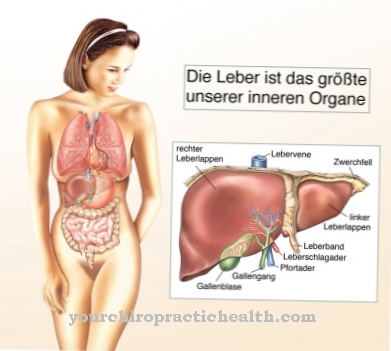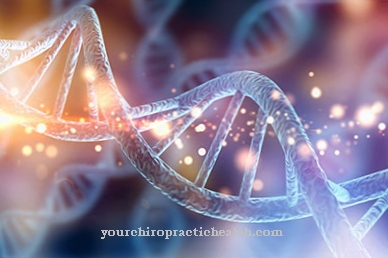Of the Joint effusion can affect different joints in the human body. The course of the disease depends primarily on the cause of the disease and the individual response to therapeutic measures.
What is joint effusion?

© SENTELLO - stock.adobe.com
With joint effusion (in medicine also referred to as Articular hydrops) is an accumulation of fluid in the joint.
The fluids that are in the joint area during a joint effusion can have different compositions depending on the person affected and the symptoms. For example, a corresponding liquid can have a bloody or purulent consistency.
Typical external symptoms that are often associated with joint effusion include swelling and / or reddening of the affected joint. The contours of the joints are often changed due to swelling. If a joint affected by the joint effusion is reddened or overheated, this indicates an acute inflammatory process.
In many cases, joint effusion is accompanied by locally limited pain, feelings of tension and restricted mobility.
causes
Joint effusion can be caused by various factors. The joint effusion is often a symptom of existing degenerative diseases that affect the joint.
Trauma (i.e. injuries resulting from external violence), damage to the articular cartilage, excessive or incorrect loading of the joint, various joint infections or inflammation of the synovium (also known as synovitis) can result in joint effusion.
In addition, various diseases, such as hemophilia (also known as hemophilia), gout (a joint disease that, among other things, is based on high uric acid levels) or joint tumors, are possible causes of joint effusion.
If an accumulation of fluid in the joint has a purulent consistency, the corresponding joint effusion is usually the result of an injury associated with an open wound. If blood collects in the joint during a joint effusion, this is in most cases due to a bleeding disorder or trauma.
You can find your medication here
➔ Medicines against swellingSymptoms, ailments & signs
Joint effusion has both general and specific symptoms. A joint effusion is usually noticeable through severe pain and swelling in the affected joints. The swellings are visible and easy to feel. They cause tension in the skin over the joint.
The contours in this area can change completely. When the knee is affected, the appearance of the floating kneecap can occur, with the kneecap changing position. Sometimes a movement of fluid in the joint is also felt. Another common symptom is severe restrictions on movement.
An acute inflammation often develops during a joint effusion, which manifests itself as reddening and overheating of the swollen joint. This can also be accompanied by chills, fever and general malaise. The course of the inflammation also depends on the type of effusion. This means that synovial fluid can increasingly accumulate in the joint. But it can also be body fluids that are usually not found in the joint.
These include blood or pus, among others. If there is an accumulation of pus, dangerous infectious inflammation with severe fever and chills are possible. The success of joint puncture treatment always depends on the cause of the effusion. Although the pressure inside the joint is always reduced with a puncture, certain causes of the disease can still worsen the symptoms.
Diagnosis & course
If a joint effusion is suspected, a consultation with the patient can usually help to narrow down the possible causes. For the purpose of a more precise diagnosis of the cause, various examination methods can be used:
As part of a joint puncture, a small amount of accumulated fluid can be removed from the joint if there is a joint effusion; the liquid obtained can now be examined in the laboratory. In order to take a closer look at the joint structures affected by a joint effusion, it is also possible, for example, to use so-called imaging methods (such as x-rays or ultrasound examinations).
The course of a joint effusion depends primarily on the cause of the disease - if a joint effusion is a chronic (long-term) disease process (such as degenerative diseases or blood coagulation disorders), the symptoms can increase steadily in some cases despite medical treatment.
Complications
The complications of a joint effusion depend to a large extent on the affected region, which is why it is generally not possible to make a universal prediction. In most cases, however, there is pain and movement restrictions. The movement restrictions can lead to psychological complaints and depression in many people and thus reduce the quality of life enormously.
The joints swell a lot and feel warm or hot. The skin is also reddened in the affected areas and may show pain at rest, which prevails even without pressure. It is not uncommon for sleep problems to occur due to the permanent pain and swelling, which can lead to an aggressive posture or irritability.
In most cases a joint effusion is treated causally, whereby the treatment mostly shows a positive sale of the disease. There are no particular complications if the person concerned does not put excessive strain on the joint and is gentle on it. The pain is also treated with the help of painkillers, which in the long term can damage the stomach. The life expectancy is not restricted by a joint effusion.
When should you go to the doctor?
People who are affected by swollen joints can cool the joints without consulting a doctor. If the swelling occurs as a result of intense physical activity, the symptoms usually subside within a short time.After a sufficient period of rest, there is no symptom. If the swelling persists for several days or if it increases in size, a doctor's visit is necessary. In the event of sudden swelling after a fall or accident, a doctor should be consulted.
If there is discoloration of the skin, pain or restricted mobility, help is needed. Consult a doctor if there are signs such as dizziness, general malaise or unsteady gait. Heat build-up or a sensation of heat directly on the joints should be examined by a doctor. If daily tasks can no longer be carried out as usual due to the complaints, a doctor's visit is required.
In the case of one-sided physical strain or poor posture, a doctor should be consulted, as permanent damage to health can develop. If the symptoms lead to behavioral problems, mood swings or a depressed appearance, a doctor's visit is necessary. Consult a doctor before using pain relievers. To avoid further complications, you should not take it yourself.
Doctors & therapists in your area
Treatment & Therapy
The medical treatment of a joint effusion depends, among other things, on factors such as the individual cause of the disease, the symptoms and the location of the affected joint. After a joint effusion has been suffered, doctors usually recommend relieving or protecting the joint first; In addition, cooling and elevating the joint can have a positive effect on the symptoms.
One possible treatment method for a joint effusion is joint puncture; the removal of accumulated fluid from the joint is not only used for diagnostic purposes, but usually also relieves the strain on the joint. If normal internal joint pressure is restored in this way, the symptoms accompanying the joint effusion usually also subside.
Depending on the patient and the severity of the symptoms, repeated puncturing of the affected joint may be necessary during the course of treatment. If joint effusion is accompanied by very severe pain in the affected person, another possible therapy component is the administration of pain-relieving medication.
An advanced course of treatment then usually integrates movement exercises to mobilize the spared joint.
In parallel to the treatment of the joint effusion, therapeutic measures are often carried out that focus on the underlying disease / injury.
Outlook & forecast
A joint effusion can proceed very differently depending on the cause. If the swelling is caused by a relatively harmless trigger such as a bruise, it will subside within a few days. If the muscle fiber or ligament ruptures, the prognosis is worse. The patient must undergo an operation and then receive physiotherapy treatment to restore the mobility of the joint. Nevertheless, the affected person has to live with mobility restrictions for the next few weeks and months.
The joint can also continue to be painful and sensitive to external stimuli and weather changes. In principle, however, the prognosis for joint effusion is very good. If the swelling is cooled immediately and then treated by a doctor, long-term consequences can usually be avoided. After a short time, the pain should have disappeared and the joint swelling itself will slowly subside.
People who suffer from a joint effusion due to a rheumatic disease have no prospect of a full recovery, as the effusion is just a symptom that can recur. Patients must receive permanent medical care and take medication for life to reduce any pain. In severe cases, rheumatism patients need support in everyday life.
You can find your medication here
➔ Medicines against swellingprevention
In particular, joint effusion, which is caused by chronic underlying diseases, can only be prevented to a limited extent; The main preventive measures here are the consistent treatment of the underlying disease. Joint effusion caused by external force can be counteracted by wearing appropriate protective clothing (e.g. when doing risky sports).
Aftercare
Joint effusion does not always have to be treated by a doctor. In many cases, home remedies are sufficient to treat this properly so that there are no further complications or complaints. First and foremost, the person concerned has to cool the effusion.
The earlier it is cooled, the smaller it becomes. The joint itself should be placed high up to allow undisturbed blood flow. Painkillers may also be taken to relieve the pain from this injury. The person affected should be careful not to take the painkillers together with alcohol, as this will significantly reduce their effect.
These should only be taken after medical advice. If the pain is very strong or the symptoms of the effusion do not go away on their own, a doctor must be consulted. Surgical intervention may also be necessary to treat the injury.
After this procedure, the affected joint should not be stressed, and strenuous activities or sporting activities should generally be avoided. The life expectancy of the person affected is usually not restricted by a joint effusion.
You can do that yourself
A joint effusion always requires a medical clarification. What measures the affected person can take themselves depends on the cause and location of the effusion. Relief and immobilization are recommended in every case.
Initially, the affected joint should be cooled and positioned upwards. After the medical treatment, the mobilization can take place step by step. Recovery can sometimes be promoted through light physiotherapy and massages. The doctor will refer the patient to a specialist for this purpose.
In order to avoid complications, independent treatment measures that go beyond restraint should be avoided. However, the symptoms can be relieved by using light home remedies. Green tea, cranberry juice or the anti-inflammatory kefir help against the pain.
Swelling can be reduced with cooling or warm pads, a salt bath or curd compress. Various homeopathic remedies have also proven themselves, such as globules with arnica or Bellis perennis, healing mud or Schüßler salts. The same applies here: discuss the use with a doctor beforehand in order to avoid problems.
If the joint effusion has not subsided after a week at the latest, further medical clarification is required.













.jpg)

.jpg)
.jpg)











.jpg)